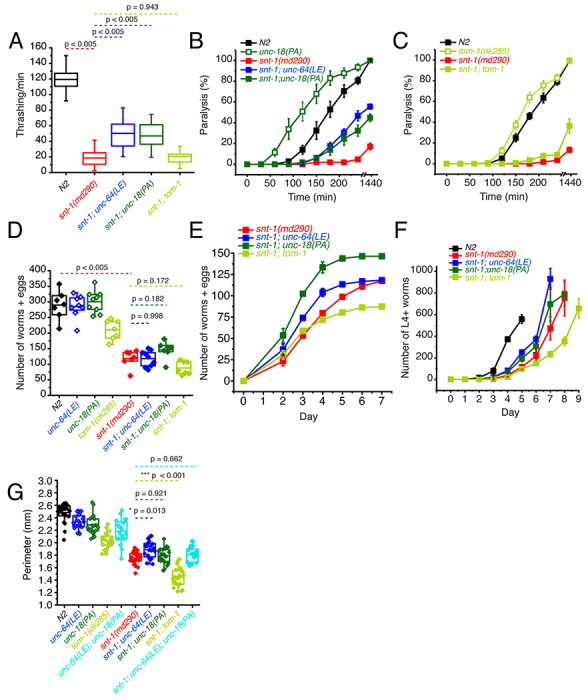Figure 1.

P334A UNC-18, open syntaxin, but not the absence of tom-1, rescues many deficits observed in the snt-1 null mutant.
(A) Box and whisker plot of thrashing for N2 control (black), snt-1 null (red), and snt-1 double mutants (with unc-64(LE), blue; unc-18(PA), dark green; tom-1(ok285), light green). One-way ANOVA was performed (F(4, 195) = 359, p = 0.00). snt-1 null worms show decreased thrashing (19 thrashes/min) and are significantly rescued by unc-64(LE) (50 thrashes/min, Tukey’s test, p < 0.005) and unc-18(PA) (47 thrashes/min, p < 0.005), but are not rescued by absence of tom-1 (21 thrashes/min, p = 0.942).
(B) Aldicarb assay of the indicated strains. snt-1 null (red) shows strong impairment of aldicarb release when compared with N2 (black). The unc-18(PA) single mutant (hollow dark green squares) increases aldicarb sensitivity further than N2 levels. Both snt-1;unc-64(LE) and snt-1;unc-18(PA), blue and solid dark green respectively, rescued the lost aldicarb sensitivity observed in the snt-1 null worm.
(C) Aldicarb assay of snt-1 rescued by absence of tom-1. tom-1 worms (hollow, light green) exhibit increased aldicarb sensitivity. Only a slight rescue is observed in the snt-1;tom-1 mutant (filled, light green).
(E) Brood size of the indicated worm strains, snt-1 worms (red) decrease in brood size when compared to N2 (black), snt-1; unc-64(LE) (in blue) and snt-1;unc-18(PA) (in dark green) have a trend for rescuing the brood size of the worm.
(F) Number of worms and eggs laid by each worm strain by day, both snt-1; unc-64(LE) in blue and snt-1;unc-18(PA) in dark green, increase the worms and eggs laid while snt-1;tom-1 decreases the worms and eggs laid.
(G) Population grown of indicated worm strains. N2 worms (black) sharply increased in population size between days 3 and 4 while snt-1 null worms (red) exhibited continuous growth, peaking between days 7 - 9. Both snt-1;unc-64(LE) and snt-1;unc-18(PA), blue and dark green respectively, grew faster than snt-1 null worms while snt-1;tom-1 (light green) grew even slower than snt-1 null worms.
(G) Box and whisker plot of worm perimeter data from indicated strains. snt-1 null worms (red) show a decrease in size, which was rescued by snt-1;unc-64(LE) (blue). snt-1;unc-18(PA) (in dark green) and snt-1;unc-64(LE); unc-18(PA) (in cyan) did not increase the size of the worm. tom-1 null worms (light green) exhibited a smaller body size, and again, snt-1;tom-1 (light green) further decreased the size of the worm.
